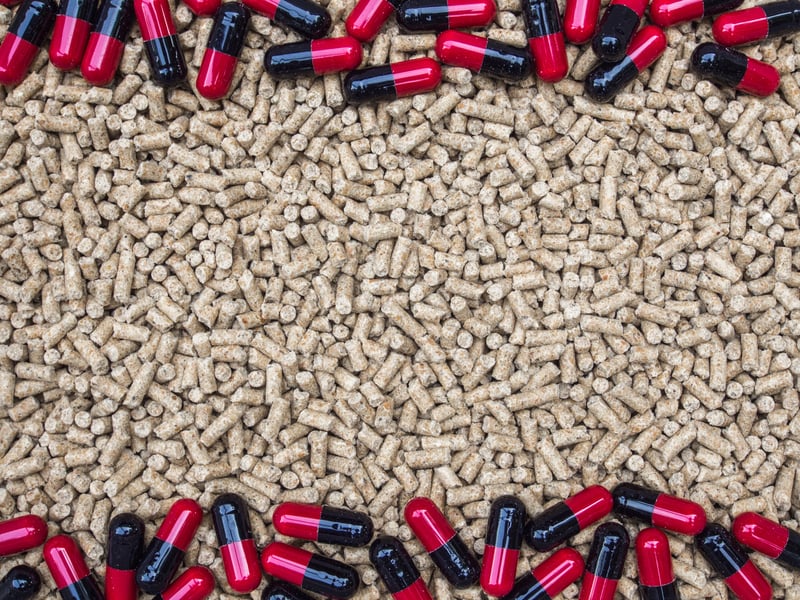
The overuse of antibiotics in farm animals is a by-product of poor animal welfare
Report
Antibiotic resistance is a serious global problem, and its connection to the well-being of farm animals is increasingly being recognized.
Our latest report, ‘Reducing Antibiotic Use in Farming Through Improvements to Animal Welfare’. This report sheds light on this critical issue, highlighting the overuse of antibiotics in intensive animal agriculture and the opportunities to improve animal management practices that would allow the reduction of antibiotic use.
Antibiotics are essential for treating bacterial diseases in animals used in food production. However, their widespread use as a preventive measure, rather than for treating sick animals, has become a common practice in intensive farming systems.
These intensive systems prioritize production and efficiency over animal health and welfare. Animals are housed in barren, crowded conditions that lead to stressed, immune-compromised animals that are more vulnerable to illness and infection. The use of preventative (prophylactic) antibiotics allows these low-welfare conditions to persist without the animals getting sick. Some antibiotics have also been found to improve feed efficiency and promote growth/weight gain, leading to their overuse further escalating.
Not only is this an animal welfare issue, but this is an urgent human health concern as well. This excessive use of antibiotics contributes to the rise of antibiotic-resistant bacteria, also known as "superbugs," which pose a significant threat to public health.
The World Health Organization (WHO) has identified antimicrobial resistance (AMR) as one of the top 10 public health threats and has estimated close to five million human deaths were associated with bacterial AMR in 2019 alone.
Due to the growing concern around AMR, some governments have passed regulations to restrict their use in farm animals. As of 2022, the preventative use of antibiotics in farm animals was banned across Europe. But what has Canada done to tackle this public health crisis?
The Canadian context: actions and gaps
Canada still allows routine prophylactic antibiotic use and antibiotics can still be used to promote growth. In fact, in 2018, Canada distributed the 6th highest quantity of antimicrobials intended for use in animals compared to 31 other countries.
Canada has recognized the importance of addressing antibiotic resistance and has implemented several initiatives to combat it. These include surveillance systems to monitor antimicrobial use and resistance in animals, as well as regulations to restrict the sale and use of medically important antibiotics without a veterinary prescription.
However, since the federal government’s release of its national action plan in 2014, there has been no commitment to fund or act on many of the recommendations. The plan needs to be updated to include mandatory restrictions, on-farm reporting of antibiotic use, and measures established to monitor and penalize those who misuse antibiotics.
We must also address the root cause driving the need for antimicrobial use on Canada’s farms in the first place – poor housing conditions for animals, regular mixing of unfamiliar animals, and substandard management practices.
Antibiotic use as a by-product of poor animal welfare
Our report highlights the interconnectedness of poor animal welfare and antibiotic overuse on farms.
Unnatural and stressful farming conditions often necessitate the use of antibiotics to compensate for these low welfare conditions that can result in health issues in animals. By improving animal welfare practices and reducing stress levels, farmers can minimize the need for antibiotics.
For example:
- Instead of giving dairy cows antibiotics to prevent diseases like mastitis, alternative practices such as frequent floor cleaning, improved milking hygiene, sand and straw bedding, ending lactation gradually rather than abruptly, and increased stall size could go a long way to reducing the need for antibiotics.
- For pigs, simple practices such as providing enrichment like straw and novelty items and reducing the number of pigs crammed into one stall could prevent disease outbreaks and the need for antibiotic overuse.
Overall, improving the living conditions for animals will help to prevent illness and reduce the need for excessive antibiotic use.
Antibiotics have a place in animal agriculture as they do in human medicine. If animals are ill, they must be treated with antibiotics for their health and welfare. It’s the misuse of antibiotics that is concerning.
Solutions: urgent actions required
Intensive farming systems that compromise animal health and welfare are driven by the rising demand for cheap animal products. To address both the animal welfare concerns and excessive antibiotic use, we must shift towards a more plant-based diet. Raising animals humanely with more space and in more natural conditions can be accomplished when animal numbers are reduced.
In addition to dietary changes, monitoring and tracking antimicrobial use on farms is crucial. This would help us understand how and why antimicrobials are used and allows us to target efforts to reduce use and prevent antibiotic resistance.
Improving current animal housing and management practices is one such effort. Changes to husbandry practices could improve animal health, meet behavioral needs, reduce stress and disease, boost immunity and ultimately reduce antimicrobial use.
Finally, industry associations and government authorities must adopt and enforce stronger regulations and policies to protect animal welfare and reduce antibiotic use
Read the report for the full list of recommendations
The consequences of AMR for human health are dire.
We must work together with our farmers to adopt higher welfare practices that facilitate a reduction in antibiotic use and ban the prophylactic use of antibiotics in farming.
We must put an end to the intensive practices that prioritize production and efficiency over animal health and welfare and put human health at risk as well.